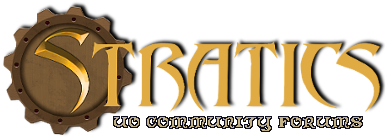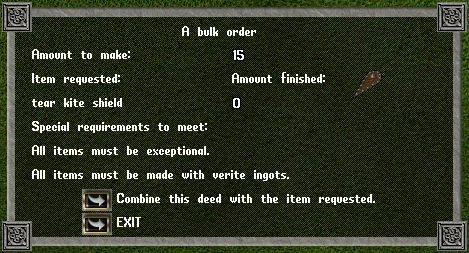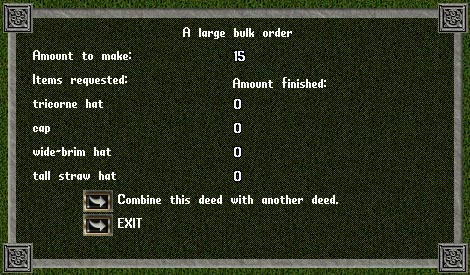Basara
UO Forum Moderator
Moderator
Professional
Governor
Stratics Veteran
Stratics Legend
Wiki Moderator
UNLEASHED
Campaign Supporter
Welcome to the Smith FAQ.
This FAQ is meant to answer many of the common (and a few of the "why didn't I think of that?") questions about the honorable skill of Blacksmithing, in Ultima Online.
Contents of the FAQ:
Section 1. Crafting in Ultima Online, AOS and later expansions
[*]Base properties, Material properties
[*]Properties imparted by Runic Hammers
[*]Examples of the combination of Runic & Material properties
[*]Enhancing items; Elemental/Neon weapons
[*]The methodology for determining the Success Chance and Exceptional Chance for crafting of items
[*]Talismans - What they are, and how they apply to the skill
Section 2. Skill Gain Section
[*]The numbers behind how the skills work and gain.
[*]Link to the New Player's Guide
[*]Several Examples of training regimens used in the past by other players
[*]Links to Tables of numbers usable to make one's own custom skill gain method
Section 3. Bulk Order Deeds
[*]What are BODs?
[*]BOD Rewards
[*]Small BOD Rewards, and when to turn in smalls instead of a single large
[*]BOD Trading tips
[*]BOD Cycling
Section 4. General Smithing Questions
[*]Blacksmith Crafting Recipes from Heartwood & Sanctuary
Last edits:
21 August 2008: Added a section on suggested small BODS to turn in for rewards, both in terms of the non-combinables and ones to not fill the larges for.
10 August 2008: Recipe Section complete.
09 August 2008: Beginning the building of the section on Recipes, and the quests to get them.
08 August 2008: BOD section edited and Restored. Only thing left now is to build the new section on Recipes for Section 4.
07 August 2008: Now that I have access to this, I'm having to go back and try to fix the near destruction of the charts by the conversion between forum formats. Repairs took all day, and a few new smaller sections added. Next up, the BOD section.
12 April 2008: Beginning work on Blacksmith Skill Gain section.
09 April 2008: Added Arms Lore Skill Gain section.
08 April 2008: Added introduction to the skill gain section, and a section to link to the revised New Smith's Guide.
07 April 2008: Added the math behind the percentages to craft and make exceptional, plus the talisman section.
06 April 2008: Sorry for the delay - the event in Moonglow has got in the way of much of my free time. Added the sections on Runic Tools, updated for the changes in Publishes 44-51. Let me know if I left out something, by PM.
20 March 2008: Transferring old entries one at a time to this new thread, to allow editing of them for content. Other than changes to this part of the document, most edits so far of the sections have been to remove the dated material from where it was meant to show differences before and after Age of Shadows. The game has now used the Age of Shadows ruleset for longer than it did the rules prior, so talking in the "Age of Shadows does this" style is unneeded, and confusing to newer players.
However, I'm leaving the spelling of "armour" as is - I'm kinda partial to it, even as an American (not like this stuff was worn except by costumers, actors and reenactors/SCA here since well before 1776, anyway).
Credits for the revised version of the FAQ will be added after the revision is done, either in this section, or in a post at the end.
This FAQ is meant to answer many of the common (and a few of the "why didn't I think of that?") questions about the honorable skill of Blacksmithing, in Ultima Online.
Contents of the FAQ:
Section 1. Crafting in Ultima Online, AOS and later expansions
[*]Base properties, Material properties
[*]Properties imparted by Runic Hammers
[*]Examples of the combination of Runic & Material properties
[*]Enhancing items; Elemental/Neon weapons
[*]The methodology for determining the Success Chance and Exceptional Chance for crafting of items
[*]Talismans - What they are, and how they apply to the skill
Section 2. Skill Gain Section
[*]The numbers behind how the skills work and gain.
[*]Link to the New Player's Guide
[*]Several Examples of training regimens used in the past by other players
[*]Links to Tables of numbers usable to make one's own custom skill gain method
Section 3. Bulk Order Deeds
[*]What are BODs?
[*]BOD Rewards
[*]Small BOD Rewards, and when to turn in smalls instead of a single large
[*]BOD Trading tips
[*]BOD Cycling
Section 4. General Smithing Questions
[*]Blacksmith Crafting Recipes from Heartwood & Sanctuary
Last edits:
21 August 2008: Added a section on suggested small BODS to turn in for rewards, both in terms of the non-combinables and ones to not fill the larges for.
10 August 2008: Recipe Section complete.
09 August 2008: Beginning the building of the section on Recipes, and the quests to get them.
08 August 2008: BOD section edited and Restored. Only thing left now is to build the new section on Recipes for Section 4.
07 August 2008: Now that I have access to this, I'm having to go back and try to fix the near destruction of the charts by the conversion between forum formats. Repairs took all day, and a few new smaller sections added. Next up, the BOD section.
12 April 2008: Beginning work on Blacksmith Skill Gain section.
09 April 2008: Added Arms Lore Skill Gain section.
08 April 2008: Added introduction to the skill gain section, and a section to link to the revised New Smith's Guide.
07 April 2008: Added the math behind the percentages to craft and make exceptional, plus the talisman section.
06 April 2008: Sorry for the delay - the event in Moonglow has got in the way of much of my free time. Added the sections on Runic Tools, updated for the changes in Publishes 44-51. Let me know if I left out something, by PM.
20 March 2008: Transferring old entries one at a time to this new thread, to allow editing of them for content. Other than changes to this part of the document, most edits so far of the sections have been to remove the dated material from where it was meant to show differences before and after Age of Shadows. The game has now used the Age of Shadows ruleset for longer than it did the rules prior, so talking in the "Age of Shadows does this" style is unneeded, and confusing to newer players.
However, I'm leaving the spelling of "armour" as is - I'm kinda partial to it, even as an American (not like this stuff was worn except by costumers, actors and reenactors/SCA here since well before 1776, anyway).
Credits for the revised version of the FAQ will be added after the revision is done, either in this section, or in a post at the end.

 There is no Spoon....
There is no Spoon.... 

